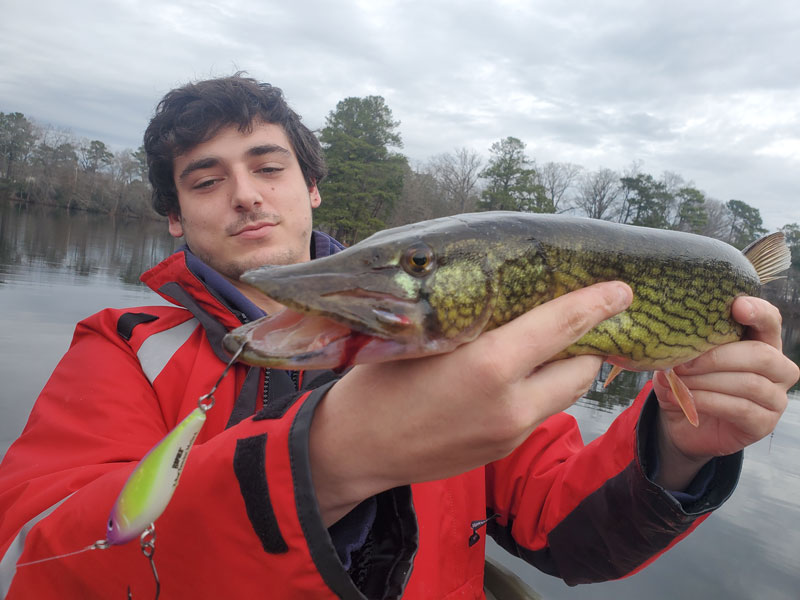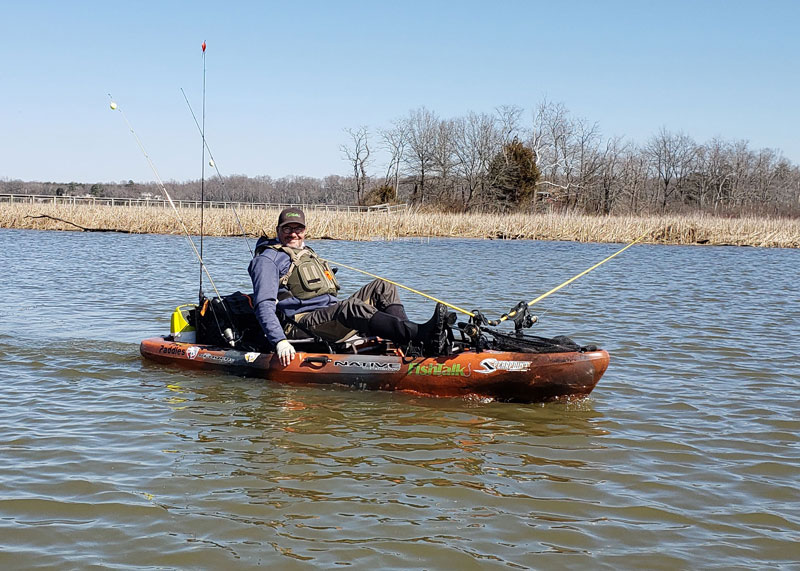You were heading out for some pickerel fishing and maybe the tackle shop was out of minnow, maybe you prefer fishing artificials, or maybe the bucket spilled in the back of your pickup and you arrived at the lake with nothing but stiff little minnow-cicles scattered across the bed—for one reason or another there will be times when your offerings are limited to lures. Which you choose and how you fish them will determine whether you sit there shivering to no avail, or end up sliding the net under a new PB.

The Preferences of Pickerel
Setting aside the availability of bait and personal preference, there are times and places where artificials will out-fish live minnow hands-down. This tends to occur when the bite is very slow, usually on bright and sunny but cold and crisp days with little to no wind.
Why do the fish behave this way? Ask the pickerel, because I have no clue. But it’s a pattern that becomes clearly evident over time, when the angler drifting minnow comes up with a skunk but the one fishing lures enjoys success multiple times per season. That said, remember, this generally happens when the bite is off so you can’t expect banner action on these days. It’s a fair guess to say that when minnow might produce a skunk, fishing lures might produce one to four fish. Still, a little action is a whole lot better than none, especially during the winter months when it takes a real effort to get out there and fish.
Remember, though, this isn’t the norm. There will be days when lures and minnow go head-to-head and more often the minnow easily outperform artificials. There will also be some days when the lures are untouched but the live baits produce fish after fish. The moral of the story? It’s impossible to predict what the fish will do from day to day, but even if you’re cool with fishing minnow and you have a full bucket, it’s still always a good idea to keep artificials on hand—especially when it’s bright and cold outside.
The Pickerel Lure De Jure
So, what should you stock up on? As a general rule pickerel love some flash and spinners can be killers. For some reason, less so when it comes to spinnerbaits and more so when it comes to inline spinners. In bright conditions silver usually wins out, and in low light gold or matte blade colors are often better. These are usually trimmed out with a three- to four-inch paddle or twister tail. Larger Mepps spinners with bucktail-dressed hooks will also prove effective.
Under-spin style lures can be big producers, too, with the Roadrunner being a classic for pounding on pickerel. Again, these can be dressed up with a paddle or twister tail. And if you happen to have minnow in that bucket, a Roadrunner tipped with a minnow is one of the all-time greats for pickerel fishing.
Another lure that will often produce fish when nothing else seems to work is a suspending twitch-bait like the Rapala X-Rap or MirrOlure Mirrodine in the three- to four-inch range. Chartreuse is always a great color choice and color preferences can naturally change from day to day, but the purple/chartreuse X-Rap has proven to be a killer through the years. If trolling is your game be it from a kayak or a small boat, shallow-diving lipped floaters in the same size range will produce, as well. Speaking of trolling…

Artipickerel Presentations
Trolling these lures at a slow walking speed is an excellent tactic, especially for kayak anglers who can roam in near-perfect stealth and give an extra kick or two every so often to get the bait working more erratically. This will certainly work from small boats propelled by electric motors, too, even more so if you keep the rod in-hand and give it a gentle jigging motion every now and again. Be sure to give those lures a regular look-see, however, because most of the areas where you’ll find pickerel will also have weeds present, even during winter when the big weedbeds have died back. One little sprig on the hook is all it takes to deter the fish from hitting.
While most trolling will take place in open water and/or along contours, it’s best to cast and retrieve when you’re targeting fish near specific structure. All of the usual suspects—stumps, downed trees, docks, and weedbed edges—can produce fish. As a general rule of thumb at this time of year pickerel tend to prefer a relatively steady and moderate retrieve with gentle jigging, as opposed to speedy retrieves and aggressive jerks of the rod tip.

We’re incredibly lucky to have uber-healthy populations of chain pickerel here in the Mid-Atlantic zone. They help ensure that year-round fishing is a thing and they’re willing to bite right through the coldest months of the year. At least they are on most days, but fish are fish and sometimes they just don’t seem to be as active as we were hoping for. The next time that bite gets lackluster and you wonder why those toothy torpedoes don’t want to play, remember to try fishing artipickerels.